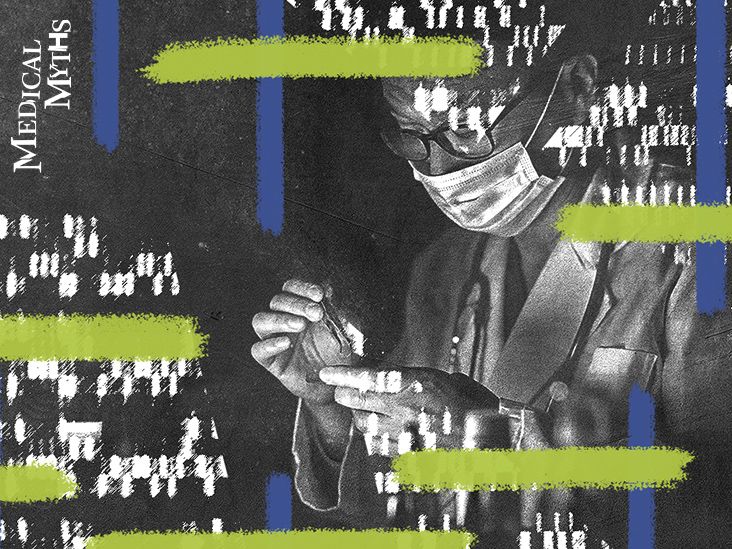
Parkinson’s disease is a neurodegenerative movement disorder. Over time, dopamine-producing cells in a part of the brain called the
This deterioration, which leads to a reduction in dopamine, produces symptoms. The symptoms tend to develop slowly over time, often starting with a slight tremor in one hand or stiffness in movement.
Aside from tremor and stiffness, other symptoms include difficulties coordinating movements, changes in posture, a fixed facial expression, a reduced sense of smell, mood changes, and sleep problems.
As the disease progresses, some people with Parkinson’s develop dementia.
In 2016, an estimated
In this article, we dispel some of the most common myths associated with Parkinson’s disease.
Article highlights:
It is true that the medical community considers Parkinson’s disease a motor disorder. However, people with the condition often also experience nonmotor symptoms, which can begin before the motor symptoms.
Nonmotor symptoms can include cognitive impairment or dementia, depression and anxiety, sleep dysfunction, pain, apathy, sexual dysfunction, and bowel incontinence.
People often overlook these symptoms, but they are important. As the authors of one paper on the topic explain:
“[N]onmotor symptoms dominate the clinical picture of advanced Parkinson’s disease and contribute to severe disability, impaired quality of life, and shortened life expectancy.”
Although there is no cure for Parkinson’s disease, drugs can help people manage the condition. One of the most
There is a long standing myth that levodopa can only relieve symptoms for about 5 years before it stops working. This is a myth. Levodopa can be effective for decades. However, over time, its effectiveness might reduce.
Medical News Today spoke with James Beck, Senior Vice President and Chief Scientific Officer of the Parkinson’s Foundation. He explained why levodopa becomes less potent:
“One of the cruel ironies about Parkinson’s disease is that the key enzyme that converts levodopa to dopamine (aromatic acid decarboxylase or AADC) is predominantly found in the dopamine neurons of the substantia nigra, which are lost during progression of the disease. So, the main way to make dopamine available to the Parkinson’s brain declines as the disease advances.”
In other words, it is not that levodopa stops being effective. Instead, the supply of the enzyme that it needs to be effective becomes more limited.
In the past, doctors and people with Parkinson’s have held off starting treatment because of fears that levodopa would slowly stop working. We now know, though, that this reduction in potency is due not to the length of time that a person takes levodopa but to the progression of the disease.
However, it is true that over time, each dose of levodopa might improve symptoms for a shorter period. This so-called
Another misconception about levodopa is that it can make Parkinson’s disease symptoms worse. This is not true.
It is important to note that levodopa can cause other motor symptoms, such as dyskinesia, which refers to involuntary jerky movements. However, the onset of dyskinesia is
Therefore, doctors no longer recommend holding off on taking levodopa until later in the disease.
According to the American Parkinson’s Disease Association (APDA), dyskinesia does not generally appear until the individual has been taking levodopa for 4–10 years. The APDA also writes:
“Dyskinesia in its milder form may not be bothersome, and the mobility afforded by taking levodopa may be preferable to the immobility associated with not taking levodopa. People with Parkinson’s must weigh the benefits from using levodopa versus the impact of dyskinesia on their quality of life.”
Tremor is the most well-known symptom of Parkinson’s disease. However, it can also occur as part of other conditions, including drug-induced parkinsonism, vascular parkinsonism, dystonic or essential tremor, psychogenic disease, and dopa-responsive dystonia.
Although doctors understand the range of symptoms that are associated with Parkinson’s, it is very difficult to predict how an individual’s disease will progress. Parkinson’s varies substantially among individuals.
As the authors of one study explain, there are “radical differences in clinical manifestations and progression between patients.”
“The [reason for the] differences observed in how individuals experience Parkinson’s disease and its progression remains unknown.” Dr. Beck explained to MNT. “It could be based on how Parkinson’s began with each individual.”
Scientists are currently
Tremor is perhaps one of the most recognizable symptoms of Parkinson’s disease. However, some people develop nonmotor symptoms before tremor appears.
Also, some individuals
Speaking with MNT, Dr. Beck explained, “About 20% of people with Parkinson’s disease do not develop a tremor.” Although scientists do not know why this is the case, Dr. Beck believes that tremor severity, in general, might depend on which brain regions the disease affects.
He noted that some scientists think “that people who have a strong tremor have lost more dopamine neurons in an area adjacent to the substantia nigra called the retrorubral area. It is these dopamine neurons (or their loss) that contribute to Parkinson’s tremor.”
In some conditions, such as multiple sclerosis, people can experience exacerbations, or flare-ups, of their symptoms. Parkinson’s disease, however, does not tend to work in this way.
The symptoms, overall, progress very slowly, although they might fluctuate throughout the day.
If someone’s symptoms do worsen suddenly, it is likely due to other factors. For instance, one
The most common cause was infection, accounting for more than 1 in 4 (25.6%) exacerbations. Other factors included anxiety, medication errors, poor adherence to medications, medication side effects, and a decline in health following surgery.
According to the authors, 81.4% of these episodes were “attributable to reversible or treatable causes.”
There is a persistent myth that drugs are the only way to ease symptoms or slow disease progression. This is a myth.
There is mounting evidence that staying physically active can reduce symptoms and potentially even slow disease progression.
The Parkinson’s Foundation explains that people with Parkinson’s “who start exercising earlier and [for] a minimum of 2.5 hours a week experience a slowed decline in quality of life compared [with] those who start later. Establishing early exercise habits is essential to overall disease management.”
Research suggests that exercise does not just reduce the motor symptoms of Parkinson’s. For instance, studies have found that exercise helps improve associated
This is a misconception. Parkinson’s is not fatal in the same way that a heart attack might be. People with Parkinson’s can live long and meaningful lives.
Compared with individuals who do not have Parkinson’s, those who do have the disease are likely to have a reduced life expectancy. This reduction is more significant for people who develop the disease at a younger age but less pronounced in those who do not develop dementia.
Although Parkinson’s is not fatal, it increases the risk of falls. Serious falls can be fatal, or they can require surgery, which increases the risk of complications or infections.
Another substantial risk is pneumonia. As people with Parkinson’s may have difficulty swallowing, they can inhale particles of food into the lungs. People with Parkinson’s also have weaker cough reflexes, so the food might stay in the lungs, where it can spark an infection.
The inability to cough out the infected material means that these infections can be fatal.
As the APDA explains, “Most patients die with Parkinson’s disease and not from it.”
Although there are still gaps in our knowledge about Parkinson’s disease, researchers continue to dive into the details. When MNT asked Dr. Beck about promising avenues of research, he said:
“I think genetic forms of Parkinson’s disease offer the best hope for treatments that may alter the course of the disease.” Scientists estimate that genetics are responsible for 10–15% of Parkinson’s cases.
“However, in order for any trial to succeed in targeting genetic Parkinson’s, we (patients and clinicians) need to know who carries disease-related mutations. Currently, no one really knows,” explained Dr. Beck.
“That is why the Parkinson’s Foundation launched PD GENEration, a national initiative that offers genetic testing and counseling at no cost for people with Parkinson’s disease. While this is not a cure for Parkinson’s now, our goals for PD GENEration are to accelerate clinical trials for the disease, improve Parkinson’s care and research, and empower people with Parkinson’s and their care teams.”
Slowly, researchers are unpicking the mechanisms at work in Parkinson’s, and, hopefully, they will one day identify more effective treatments and perhaps even a cure.



